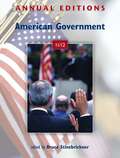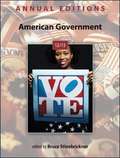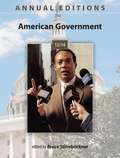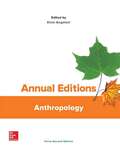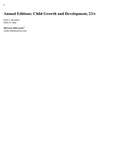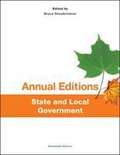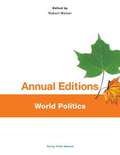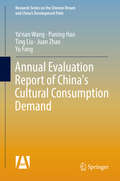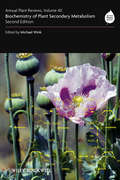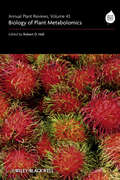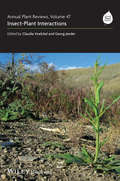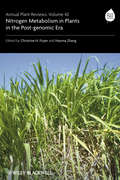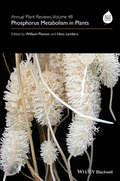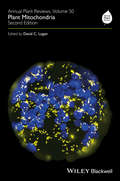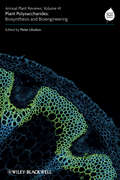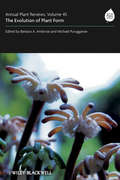- Table View
- List View
Annual Editions: American Government 11/12 (41st Edition)
by Bruce StinebricknerThe Annual Editions series is designed to provide convenient, inexpensive access to a wide range of current articles from some of the most respected magazines, newspapers, and journals published today. Annual Editions are updated on a regular basis through a continuous monitoring of over 300 periodical sources. The articles selected are authored by prominent scholars, researchers, and commentators writing for a general audience. The Annual Editions volumes have a number of common organizational features designed to make them particularly useful in the classroom: a general introduction; an annotated table of contents; a topic guide; an annotated listing of selected World Wide Web sites; and a brief overview for each section. Each volume also offers an online Instructor's Resource Guide with testing materials. Using Annual Editions in the Classroom is a general guide that provides a number of interesting and functional ideas for using Annual Editions readers in the classroom. Visit www.mhhe.com/annualeditions for more details.
Annual Editions: American Government 12/13 (42nd Edition)
by Bruce StinebricknerThe Annual Editions series is designed to provide convenient, inexpensive access to a wide range of current articles from some of the most respected magazines, newspapers, and journals published today. Annual Editions are updated on a regular basis through a continuous monitoring of over 300 periodical sources. The articles selected are authored by prominent scholars, researchers, and commentators writing for a general audience. Annual Editions volumes have a number of organizational features designed to make them especially valuable for classroom use: a general introduction; an annotated table of contents; a topic guide; an annotated listing of supporting World Wide Web sites; Learning Outcomes and a brief overview at the beginning of each unit; and a Critical Thinking section at the end of each article. Each volume also offers an online Instructor's Resource Guide with testing materials. Using Annual Editions in the Classroom is a general guide that provides a number of interesting and functional ideas for using Annual Editions readers in the classroom. Visit www.mhhe. com/annualeditions for more details.
Annual Editions: American Government 13/14
by Bruce StinebricknerThe Annual Editions series is designed to provide convenient, inexpensive access to a wide range of current articles from some of the most respected magazines, newspapers, and journals published today. Annual Editions are updated on a regular basis through a continuous monitoring of over 300 periodical sources. The articles selected are authored by prominent scholars, researchers, and commentators writing for a general audience. Annual Editionsvolumes have a number of organizational features designed to make them especially valuable for classroom use: a general introduction; an annotated table of contents; a topic guide; an annotated listing of supporting World Wide Web sites;Learning Outcomes and a brief overview at the beginning of each unit; and a Critical Thinking section at the end of each article. Each volume also offers an online Instructor's Resource Guide with testing materials. Using Annual Editions in the Classroom is a general guide that provides a number of interesting and functional ideas for using Annual Editions readers in the classroom.
Annual Editions: Anthropology
by Elvio AngeloniThe Annual Editions series is designed to provide convenient inexpensive access to a wide range of current articles from some of the most respected magazines, newspapers and journals published today. Annual Editions are updated on a regular basis through a continuous monitoring of over 300 periodical sources. The articles selected are authored by prominent scholars, researchers, and commentators writing for a general audience. Each Annual Editions volume has a number of features designed to make them especially valuable for classroom use; including a brief overview for each unit, as well as Learning Outcomes, Critical Thinking questions, and Internet References to accompany each article. Go to the McGraw-Hill Create Annual Editions Article Collection at http://www.mcgrawhillcreate.com/annualeditions to browse the entire collection. Select individual Annual Editions articles to enhance your course, or access and select the entire Angeloni: Annual Editions: Anthropology, 42/e book here http://create.mheducation.com/createonline/index.html#qlink=search%2Ftext%3Disbn:126018031X for an easy, pre-built teaching resource. Visit http://create.mheducation.com for more information on other McGraw-Hill titles and special collections.
Annual Editions: Anthropology, 40/e
by Elvio AngeloniThe Annual Editions series is designed to provide convenient inexpensive access to a wide range of current articles from some of the most respected magazines, newspapers and journals published today. Annual Editions are updated on a regular basis through a continuous monitoring of over 300 periodical sources. The articles selected are authored by prominent scholars, researchers, and commentators writing for a general audience. Each Annual Editions volume has a number of features designed to make them especially valuable for classroom use; including a brief overview for each unit, as well as Learning Outcomes, Critical Thinking questions, and Internet References to accompany each article.
Annual Editions: Child Growth And Development
by Chris J. Boyatzis Ellen N. JunnThe Annual Editions series is designed to provide convenient inexpensive access to a wide range of current articles from some of the most respected magazines, newspapers and journals published today. Annual Editions are updated on a regular basis through a continuous monitoring of over 300 periodical sources. The articles selected are authored by prominent scholars, researchers, and commentators writing for a general audience. Each Annual Editions volume has a number of features designed to make them especially valuable for classroom use; including a brief overview for each unit, as well as Learning Outcomes, Critical Thinking questions, and Internet References to accompany each article. Go to the McGraw-Hill Create® Annual Editions Article Collection at http://www.mcgrawhillcreate.com/annualeditions to browse the entire collection. Select individual Annual Editions articles to enhance your course, or access and select the entire Boyatzis/Junn: Annual Editions: Child Growth and Development, 23/e book here http://create.mheducation.com/createonline/index.html#qlink=search%2Ftext%3Disbn:1259910903 for an easy, pre-built teaching resource. Visit http://create.mheducation.com for more information on other McGraw-Hill titles and special collections.
Annual Editions: Health 12/13 (33rd Edition)
by Eileen L. DanielThe 'Annual Editions' series is designed to provide convenient, inexpensive access to a wide range of current articles from some of the most respected magazines, newspapers, and journals published today. 'Annual Editions' are updated on a regular basis through a continuous monitoring of over 300 periodical sources.
Annual Editions: Human Development, 43/e
by Karen FreibergThe Annual Editions series is designed to provide convenient, inexpensive access to a wide range of current articles from some of the most respected magazines, newspapers, and journals published today. Annual Editions are updated on a regular basis through a continuous monitoring of over 300 periodical sources. The articles selected are authored by prominent scholars, researchers, and commentators writing for a general audience. Each Annual Editions volume has a number of features designed to make them especially valuable for classroom use: an annotated Table of Contents, a Topic Guide, an annotated listing of supporting websites, Learning Outcomes and a brief overview for each unit, and Critical Thinking questions at the end of each article. Go to the McGraw-Hill CreateTM Annual Editions Article Collection at www. mcgrawhillcreate. com/annualeditions to browse the entire collection. Select individual Annual Editions articles to enhance your course, or access and select the entire Freiberg: Annual Editions: Human Development, 43/e ExpressBook for an easy, pre-built teaching resource by clicking here. An online Instructor's Resource Guide with testing material is available for each Annual Editions volume. Using Annual Editions in the Classroom is also an excellent instructor resource. Visit the Create Central Online Learning Center at www. mhhe. com/createcentral for more details.
Annual Editions: Prehistory to 1500
by Helen Buss Mitchell Joseph R. MitchellThe Annual Editions series is designed to provide convenient, inexpensive access to a wide range of current articles from some of the most respected magazines, newspapers, and journals published today. Annual Editions are updated on a regular basis through a continuous monitoring of over 300 periodical sources. The articles selected are authored by prominent scholars, researchers, and commentators writing for a general audience.
Annual Editions: State and Local Government
by Bruce StinebricknerThe Annual Editions series provides students with convenient, inexpensive access to current, carefully selected articles from the public press. Beginning with the first edition in 1984, the book has been designed for use in courses on state and local government and in state and local government segments of courses on American government. The educational goal is to provide a collection of up-to-date articles that are informative and interesting to students who are learning about subnational governments in the United States. Annual Editions: State and Local Government, 16/e is an easy-to-use reader that presents articles on important topics such as economic development, federalism, policymaking, and many more.
Annual Editions: Technologies, Social Media, And Society, 21/e
by Caroline Shaffer WesterhofThe Annual Editions series is designed to provide convenient, inexpensive access to a wide range of current articles from some of the most respected magazines, newspapers, and journals published today. Annual Editions are updated on a regular basis through a continuous monitoring of over 300 periodical sources. The articles selected are authored by prominent scholars, researchers, and commentators writing for a general audience.
Annual Editions: World Politics 35th Edition
by Robert WeinerThis book on World Politics is designed to provide convenient, inexpensive access to a wide range of current articles from some of the most respected magazines, newspapers, and journals published today.
Annual Evaluation Report of China's Cultural Consumption Demand (Research Series on the Chinese Dream and China’s Development Path)
by Ya'Nan Wang Puning Hao Ting Liu Juan Zhao Yu FangGathering contributions by leading social development scholars, this report offers a comprehensive description of the national development of cultural consumption in China. By comparing the annual growth of cultural consumption, GDP growth, per-capita income growth and savings growth, the authors reveal the disparity between urban and rural areas in terms of cultural consumption, as well as that between provinces. Based on an analysis of the status quo of cultural consumption in China, the book explores the road to a prosperous society and enhancing China's cultural development.
Annual Fishes: Life History Strategy, Diversity, and Evolution
by Ronald EislerAnnual Fishes: Life History Strategy, Diversity, and Evolution is the first comprehensive reference on current knowledge of diverse species that exhibit unique survival strategies and provide important models for basic and applied research. This work fills a void, covering the life cycle, reproductive biology, evolutionary ecology, reproductive beh
Annual Haircut Day
by NoniSringeri Srinivas had very long hair. He wanted it cut on Annual Haircut Day. Everyone was busy. You will never guess who helped him that day! Read and enjoy!
Annual Plant Reviews, Biochemistry of Plant Secondary Metabolism (Annual Plant Reviews #62)
by Michael WinkThis brand new Annual Plant Reviews volume is the second edition of the highly successful and well-received Annual Plant Reviews, Volume 2. This exciting new volume provides an up-to-date survey of the biochemistry and physiology of plant secondary metabolism. The volume commences with an overview of the biochemistry, physiology and function of secondary metabolism, followed by detailed reviews of the major groups of secondary metabolites: alkaloids and betalains, cyanogenic glucosides, glucosinolates and nonprotein amino acids, phenyl propanoids and related phenolics, terpenoids, cardiac glycosides and saponins. A final chapter discusses the evolution of secondary metabolism. This carefully compiled new edition brings together chapters from some of the world's leading experts in plant secondary metabolism. Completely revised and brought right up to date with much new information, this volume is an essential purchase for advanced students, researchers and professionals in biochemistry, physiology, molecular biology, genetics, plant sciences, agriculture, medicine, pharmacology and pharmacy, working in the academic and industrial sectors, including those working in the pesticide and pharmaceutical industries. Libraries in all universities and research establishments where these subjects are studied and taught will need copies of this excellent volume on their shelves. A companion volume Annual Plant Reviews Volume 39, Functions and Biotechnology of Plant Secondary Metabolites, Second Edition, Edited by M. Wink, is also available.
Annual Plant Reviews, Biology of Plant Metabolomics (Annual Plant Reviews #59)
by Robert D. HallBiology of Plant Metabolomics is an exciting new volume in Wiley-Blackwell's highly successful Annual Plant Reviews series. Concentrating on the biology and biological relevance of plant metabolomics, each chapter, written by internationally-acknowledged experts in the field from at least two different research groups, combines a review of the existing biological results with an extended assessment of possible future developments and the impact that these will have on the type of research needed for the future. Following a general introduction, this exciting volume includes details of metabolomics of model species including Arabidopsis and tomato. Further chapters provide in-depth coverage of abiotic stress, data integration, systems biology, genetics, genomics, chemometrics and biostatisitcs. Applications of plant metabolomics in food science, plant ecology and physiology are also comprehensively covered. Biology of Plant Metabolomics provides cutting edge reviews of many major aspects of this new and exciting subject. It is an essential purchase for plant scientists, plant geneticists and physiologists. All libraries in universities and research establishments where biological sciences are studied and taught should have a copy of this Annual Plant Reviews volume on their shelves.
Annual Plant Reviews, Insect-Plant Interactions (Annual Plant Reviews)
by Claudia Voelckel Georg JanderThis latest volume in Wiley Blackwell’s prestigious Annual Plant Reviews brings together articles that describe the biochemical, genetic, and ecological aspects of plant interactions with insect herbivores.. The biochemistry section of this outstanding volume includes reviews highlighting significant findings in the area of plant signalling cascades, recognition of herbivore-associated molecular patterns, sequestration of plant defensive metabolites and perception of plant semiochemicals by insects. Chapters in the genetics section are focused on genetic mapping of herbivore resistance traits and the analysis of transcriptional responses in both plants and insects. The ecology section includes chapters that describe plant-insect interactions at a higher level, including multitrophic interactions, investigations of the cost-benefit paradigm and the altitudinal niche-breadth hypothesis, and a re-evaluation of co-evolution in the light of recent molecular research. Written by many of the world’s leading researchers in these subjects, and edited by Claudia Voelckel and Georg Jander, this volume is designed for students and researchers with some background in plant molecular biology or ecology, who would like to learn more about recent advances or obtain a more in-depth understanding of this field. This volume will also be of great use and interest to a wide range of plant scientists and entomologists and is an essential purchase for universities and research establishments where biological sciences are studied and taught. To view details of volumes in Annual Plant Reviews, visit: www.wiley.com/go/apr Also available from Wiley: Plant Defense Dale Walters 9781405175890 Herbicides and Plant Physiology, 2nd Edn Andrew Cobb & John Reade 9781405129350
Annual Plant Reviews, Nitrogen Metabolism in Plants in the Post-genomic Era (Annual Plant Reviews #60)
by Hanma Zhang Christine H. FoyerThe field of plant nitrogen metabolism continues to be a compelling focus for basic research activities because there is a strong demand for immediate solutions, particularly in key areas, such as improving plant nitrogen use efficiency, which are crucial to future agricultural sustainability and the future economic success of agriculture. The 13 reviews which comprise this excellent and carefully edited new volume bring together the expertise and enthusiasm of an international team of leading researchers. Topics covered include nitrogen sensing and signalling, uptake and membrane systems, nitric oxide, primary nitrogen assimilation and C/N balance and interactions, and regulation of root and plant architecture. Together, these reviews provide an insight into how plants sense, uptake and assimilate nitrogen into the organic compounds required for growth, co-ordinate nitrogen and carbon metabolism and regulate growth and development according to nitrogen availability. The transcription factors that act to integrate environmental nutrient (nitrogen) signals to co-ordinate primary and secondary metabolism are discussed, together with new concepts of cross-talk, transport and signalling, and how such molecular networks influence nitrogen and carbon cycling processes in the environment. Annual Plant Reviews, Volume 42: Nitrogen Metabolism in Plants in the Post-genomic Era is an essential purchase for advanced students, researchers and professionals in plant sciences, biochemistry, physiology, molecular biology, genetics and agricultural sciences, working in the academic and industrial sectors. Libraries in all universities and research establishments where these subjects are studied and taught will need copies of this excellent volume on their shelves.
Annual Plant Reviews, Phosphorus Metabolism in Plants
by Hans Lambers William Plaxtonal P uptake and metabolism, this book provides insights as to how plants sense, acquire, recycle, scavenge, and use P, particularly under the naturally-occurring condition of soluble inorganic phosphate deficiency that characterizes the vast majority of unfertilized soils, world-wide. It gives the reader a full appreciation of the diverse information concerning plant P-starvation responses, as well as the crucial role that plant-microbe interactions play in plant P-acquisition.Annual Plant Reviews, Volume 48: Phosphorus Metabolism in Plants is an important resource for plant geneticists, biochemists, and physiologists, as well as horticultural and environmental researchers and advanced students of plant science and university lecturers in related disciplines. It is an essential addition to the shelves of university and research institute libraries and agricultural and ecological institutions teaching and researching plant science.
Annual Plant Reviews, Plant Mitochondria
by David C. LoganThis long-awaited second edition covers the major changes that have occurred in the field over the last decade Completely revised with the most up-to-date research and including brand new chapters, Annual Plant Reviews, Volume 50: Plant Mitochondria, 2nd Edition presents the multifaceted roles of mitochondria in plants. The book starts with a short history of plant mitochondrial research; discusses how coevolution shaped plant mitochondrial gene expression; explains control of number, shape, size, and motility of mitochondria; delves into stress responses and roles in stress alleviation in mitochondrial biochemistry; covers the damage repair pathway of the Calvin-Benson cycle; and more. Containing sections written by many of the world’s leading researchers in this area, this book brings together and reviews for the first time many recent advances. It offers chapters on: Bioblasts, Cytomikrosomen & Chondriosomes; The Crosstalk Between Genomes; The Dynamic Chondriome; Metal Homeostasis in Plant Mitochondria; RNA Metabolism and Transcript Regulation; Mitochondrial Regulation and Signalling in the Photosynthetic Cell; Mitochondrial Biochemistry; Ecophysiology of Plant Respiration; Photorespiration; and Mitochondria and Cell Death. Annual Plant Reviews, Volume 50: Plant Mitochondria, 2nd Edition is an extremely important and timely book that will be of great use and interest to plant scientists, cell and molecular biologists, and biochemists.
Annual Plant Reviews, Plant Nuclear Structure, Genome Architecture and Gene Regulation (Annual Plant Reviews)
by John A. Bryant Katja Graumann David E. EvansThis timely volume brings together expert reviews of the recent significant advances in our knowledge and understanding of the organisation of the higher plant nucleus, and in particular in the relationship between nuclear organisation and the regulation of gene expression. Rapid progress has been made in a number of key areas over the last five years, including description and characterization of proteins of the nuclear envelope and nuclear pore complex, novel insights into nucleoskeletal structures, as well as developments related to chromatin organization, function and gene expression. These advances open the way for new research into areas such as stress tolerance, plant-pathogen interactions and ultimately crop improvement and food security. Continued research into plant nuclear structure, genome architecture and gene regulation also enriches our understanding of the origin and evolution of the nucleus and its envelope. Edited by world-class researchers in plant cell biology, and comprising contributions from internationally-renowned academics, this latest volume in the prestigious Annual Plant Reviews series brings together a wealth of knowledge in the burgeoning field of plant nuclear structure and genetics. Annual Plant Reviews, Volume 46: Plant Nuclear Structure, Genome Architecture and Gene Regulation is a vital resource for advanced students, researchers and professionals in plant science and related disciplines. Libraries in all research establishments where plant science, biochemistry, molecular biology, genetics and genomics and agricultural science are taught and studied will find this excellent volume an essential addition to their shelf.
Annual Plant Reviews, Plant Polysaccharides: Biosynthesis and Bioengineering (Annual Plant Reviews Ser. #51)
by Peter UlvskovPlant Polysaccharides, an exceptional new volume in Wiley-Blackwell’s successful Annual Plant Reviews series, covers the polysaccharides and proteins that form the fundamental architecture of the plant cell wall, and the genes that encode the cellular machinery that synthesizes them. The volume focuses on the evolution of the many families of genes whose products are required to make a particular kind of polysaccharide, bringing attention to the specific biochemical properties of the proteins to the level of kinds of sugar linkages they make. Beautifully illustrated in full colour throughout, this exceptional new volume provides cutting edge up-to-date information on such important topics as cell wall biology, composition and biosynthesis, glycosyltransferases, hydroxyproline-rich glycoproteins, enzymatic modification of plant cell wall polysaccharides, glycan engineering in transgenic plants, and polysaccharide nanobiotechnology. Drawing together some of the world’s leading experts in these areas, the editor, Peter Ulvskov, has provided a landmark volume that is essential reading for plant and crop scientists, biochemists, molecular biologists and geneticists. All libraries in universities and research establishments where plant sciences, agriculture, biological, biochemical and molecular sciences are studied and taught should have copies of this important volume.
Annual Plant Reviews, The Evolution of Plant Form (Annual Plant Reviews)
by Barbara A. Ambrose Michael PuruggananThe Evolution of Plant Form is an exceptional new volume in Wiley-Blackwell’s highly successful and well established Annual Plant Reviews. Written by recognised and respected researchers, this book delivers a comprehensive guide to the diverse range of scientific perspectives in land plant evolution, from morphological evolution to the studies of the mechanisms of evolutionary change and the tools with which they can be studied. This title distinguishes itself from others in plant evolution through its synthesis of these ideas, which then provides a framework for future studies and exciting new developments in this field. The first chapter explores the origins of the major morphological innovations in land plants and the following chapters provide an exciting, in depth analysis of the morphological evolution of land plant groups including bryophytes, lycophytes, ferns, gymnosperms and angiosperms. The second half of the book focuses on evolutionary studies in land plants including genomics, adaptation, development and phenotypic plasticity. The final chapter provides a summary and perspective for future studies in the evolution of plant form. The Evolution of Plant Form provides essential information for plant scientists and evolutionary biologists. All libraries and research establishments, where biological and agricultural sciences are studied and taught, will find this important work a vital addition to their shelves.
